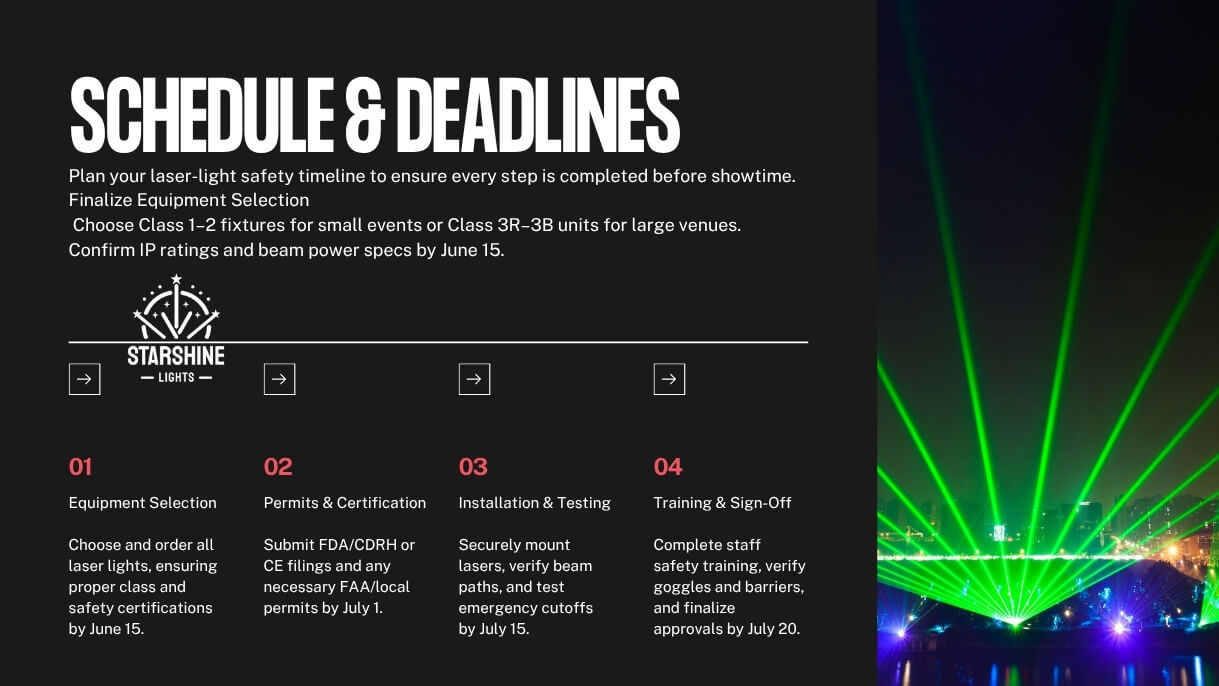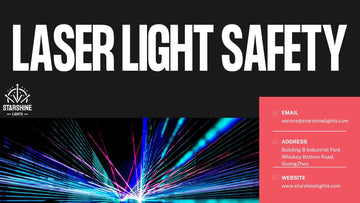Safety Tips for Using Laser Lights
Laser lights—from LED laser lights to high-power rigs—bring spectacular laser lighting effects to any event, whether it’s a cozy backyard party or a pulsating nightclub. But with great visual impact comes responsibility.
As a seasoned lighting designer working with Starshine, I’ve seen firsthand how party laser lights, outdoor projector laser lights, and nightclub laser lights can transform spaces while demanding strict safety measures. In this guide, I’ll share essential laser safety tips so you can enjoy vibrant laser light displays without risking eye or skin harm.
Understanding Laser Lights and Laser Light Systems
Before diving into safety, let’s cover what laser lights are and why they require special precautions. Laser lights produce extremely focused beams—unlike diffuse LED strips, laser beams travel long distances with minimal spread. This high intensity explains why a single B6 RGB Laser Bar Light from Starshine can paint entire walls with swirling red green and blue patterns, while a B8 Red Laser Light Bar slices through fog with razor-sharp precision.
Key Features of Laser Light Systems
Type of Laser: Most consumer show lights use Class 1 or Class 2 diodes, safe under normal operation. Professional rigs employ high power lasers (Class 3R or 3B) for large venues. Choose based on application—laser halloween lights for a home haunt require lower power than stage lighting for a concert.
Ability to Adjust Beam: Lenses, gobos, and prisms let you modify beam width, angle, and pattern shape. Starshine’s B3 Moving Head Lasers combine laser projector precision with dynamic movement, enabling you to fine-tune lighting effects remotely.
Color Options: RGB laser sources blend red, green, and blue into millions of hues. The B4 RGB Laser Bar delivers vibrant multi-color effects, perfect for laser party lights.
Why Laser Lights Demand Safety
A concentrated laser beam can damage the retina if aimed directly at eyes. Unlike LED fixtures, which scatter light, lasers focus energy into a tiny point—think of sunlight through a magnifying glass. That intensity makes laser safety paramount. Whether using outdoor projector laser lights for a garden show or disco-style dj laser lights under a nightclub rig, I’ll walk you through best practices to mitigate risks.
1. Choose the Right Laser Lights for Your Needs
What Should You Look for When Buying Laser Lights?
Ask Questions: What class of laser do you need? For most indoor parties or small outdoor shows, Class 1 or 2 devices—like the B6 RGB Laser Bar Light—deliver festive colorful laser lights safely. If you need beams that cut through stadium haze, you might consider Class 3R moving head lasers (e.g., the B3 model), but these require stricter safety protocols.
Compare Specifications: Look for key specs—beam power (mW), wavelength, and scatter angle. If a fixture lists “high power lasers” but omits beam divergence, it’s a red flag.
Check Certifications: Only buy projectors marked with FDA/CDRH (in the United States) or CE (in Europe) approval. These seals confirm that the laser light projector meets established safety thresholds.
导购词 (Buying Guide Tip): When choosing laser lights outdoor, prioritize IP ratings (waterproofing) and mounting options. The B8 Red Laser Light Bar is IP65-rated, making it ideal for garden displays.

2. Understand Laser Classifications and Power Levels
Question Words: What does “Class 2” or “Class 3B” mean?
Laser devices fall into categories based on risk:
Class 1 & Class 2: Low risk under normal operation. Class 2 beams are visible and safe for short eye exposure (0.25s) due to natural blink reflex. These classes suit most dj laser lights or laser halloween lights for home use.
Class 3R & Class 3B: Medium power—risky if viewed directly. These are common in professional laser shows. If you choose a Class 3B stage lighting unit like the B3 Moving Head Lasers, you must implement strict access controls.
Class 4: High-power lasers used in industrial or scientific settings. These require a controlled environment—avoid these for entertainment unless you’re an experienced technician.
Information Phrase: Always verify the type of laser before operation. If a unit’s label says “Class 3R” or “Class 3B,” plan for extra safety measures (barriers, signage, and operator training).

3. Safe Installation Practices
How to Install Laser Lights Safely
Mount Securely: Fix your laser light installation to a stable stand or truss. Avoid placing laser lights outdoor on uneven ground where wind or curious guests can topple them.
Position at Height: Aim beams above eye level. By directing lasers at ceilings, trees, or high walls, you reduce the chance someone accidentally glances into a beam. For nightclub rigs, hang nightclub laser lights from trusses 8–12 feet high.
Use Protective Enclosures: For high power lasers, house the source inside a secure enclosure that only emits the beam through aperture slits. This prevents stray reflections. Starshine’s B3 Moving Head Lasers include protective front windows locking the optics in place.
When installing outdoor projector laser lights for a garden party, choose locations away from pedestrian paths. The B4 RGB Laser Bar often serves as a balcony-mounted fixture, shining down onto shrubs and walls—never at face level.
4. Avoid Direct Eye Exposure
Direct beam contact can cause retinal burns.
Set Boundaries: Use physical barriers—stanchions or guard rails—to keep audiences at a safe distance, especially with high power lasers.
Follow Line-of-Sight Rules: Ensure the beam path never intersects with areas where people stand or walk. For laser light shows, program your sequences so beams remain above head height.
Educate Attendees: Announce “Do not look directly at laser beams” via signage or verbal warnings before the show starts. Clear communication helps prevent accidental stares.
Unlike diffuse LED strip lights, lasers maintain focus over long distances—so even a weak 50 mW beam can injure if someone stares into it from nearby.
5. Use Appropriate Eye Protection
When to Wear Laser Safety Goggles
Pro-Level Lasers: If you’re a technician or performer working around Class 3B or Class 4 fixtures, goggles rated for your laser’s wavelength (e.g., 650 nm for red lasers) are mandatory.
High-Intensity Spots: Even LED laser lights with powerful diodes can be harmful at close range. Whenever you need to align or adjust the beam, pop on protective eyewear.
Nearby Personnel: If you have crew members near the beam path during setup or tear-down, provide them with goggles that block the beam’s primary wavelength.
Always check the goggle’s optical density (OD)—OD > 3 for 650 nm red lasers, OD > 4 for 532 nm green lasers—ensures proper attenuation to prevent damage.
6. Be Aware of Reflective Surfaces
Mirrors and glossy surfaces can bounce beams unpredictably.
Check the Venue: Before you power up colorful laser lights, scan for mirrors, windows, or polished metal surfaces. A stray reflection could send a beam back toward the crowd or even into adjacent rooms.
Adjust Beam Path: If you spot reflective objects, redesign your layout. Angle beams away from shiny tables or glass walls. Consider adding non-reflective backdrops behind your show lights laser rigs.
Temporary Coverings: For one-night-only gigs, installing opaque cloth behind the beam path prevents unwanted reflections. This simple step keeps your laser light display contained.
In contrast to fog machines—where beams shine through haze for effect—reflected beams can be intense even without fog, making reflections potentially more dangerous.
7. Adhere to Local Regulations
What Rules Govern Laser Shows in Your Area?
United States: The FDA’s CDRH oversees laser safety for consumer and professional devices. Check 21 CFR 1040.10/1040.11 for classification details. For outdoor events, you must file a “Notice of Intent” (NOI) with the FAA if beams might cross airspace.
Europe: Look for CE/IEC 60825 certification. Local municipalities might require additional permits for public laser shows, especially around protected zones (e.g., wildlife areas).
If you’re planning laser lights outdoor for a large festival, consult with local authorities at least 30 days before the event. Securing permits early ensures you don’t end up canceling due to red tape.
8. Special Considerations for Outdoor Laser Light Shows
Avoid Airplane and Vehicle Interference
FAA Compliance: Never point lasers skyward near airports or flight paths. Even low-power outdoor projector laser lights can distract pilots. Use exclusion zones on your lighting plan.
Driver Distraction: Position beams so they never face public roads. A bright beam of light crossing a highway could cause accidents. Always scan your setup visually from different angles, ideally during twilight, to spot unintended paths.
Consider Weather Conditions
Fog, Rain, and Snow: Moisture scatters laser beams, expanding their footprint. While this can enhance effect in a laser light show, it also creates stray light that might reach unintended areas. Adjust your beam angle downward or use fewer fixtures if humidity is high.
Wind: Strong breezes can knock over lightweight laser light projector stands. Anchor tripods and secure cables with sandbags.
Temperature Extremes: High heat may cause LED bulbs to overheat. Ensure adequate ventilation for smart lighting systems and avoid direct sun to prolong lamp life.
If rain is likely, use waterproof housings (IP65 or higher). Starshine’s bar lights, like the B6 RGB Laser Bar Light, meet these standards, so you can keep shining through drizzle.
9. Communicate with Your Audience
How to Keep Spectators Safe and Informed
Pre-Show Announcements: Before starting any laser shows, remind guests via PA or signage: “Do not look directly at lasers.”
Visible Signage: Place “Laser in Use” warnings at entry points. It’s not just for liability—it helps people stay alert.
Proximity Warnings: If your laser light display uses high-power fixtures near seating areas, place floor markings that show safe zones.
Unlike static LED fixtures—where glare is minimal—laser beams can startle or harm if viewers aren’t prepared. Clear communication eliminates surprises.
10. Maintain and Inspect Your Laser Light Equipment
Routine Checks for Continued Safety
Inspect Cables & Connections: Frayed wires can short and cause flickering beams—always check connections before powering on.
Test Emergency Shutoffs: Professional laser projector units often include a hardware kill switch. Test it monthly to confirm it cuts power immediately.
Clean Lenses and Optics: Dust buildup reduces beam clarity, leading operators to crank up power. Keep lenses clean with a soft, lint-free cloth and appropriate cleaning solution.
Monitor Diode Lifespan: LED laser lights can last tens of thousands of hours, but thin wattage diodes degrade over time. When you notice color shifts or reduced output, schedule diode replacements.
Keep a spare set of LED bulbs or diode modules on hand so you can swap them quickly and avoid downtime—especially during critical gigs.

Conclusion: Prioritizing Laser Safety for Spectacular Shows
Laser lights—from dj laser lights in nightclubs to outdoor projector laser lights on rooftops—create unforgettable experiences. But without proper precautions, laser lighting effects can turn dangerous. By choosing the right type of laser, adhering to local regulations, installing fixtures securely, and educating your audience, you ensure every beam dazzles without harm.
Whether you’re shopping for a B6 RGB Laser Bar Light, experimenting with laser halloween lights, or running a massive laser shows tour, laser safety must stay at the forefront. I’m confident that following these tips will help you choose, buy, and operate your laser lights outdoor with professional precision—delivering awe-inspiring visuals while keeping everyone safe.



























